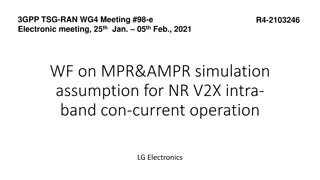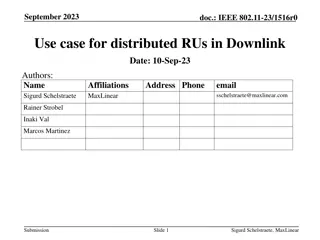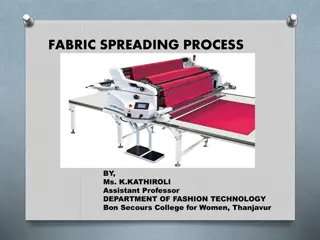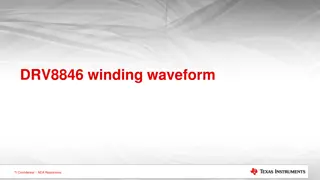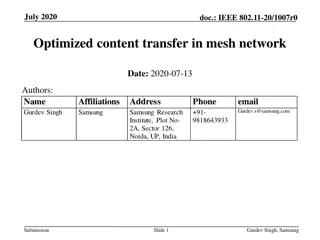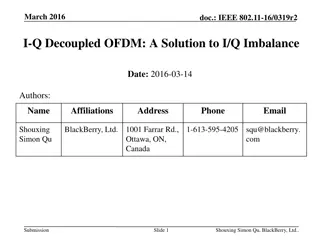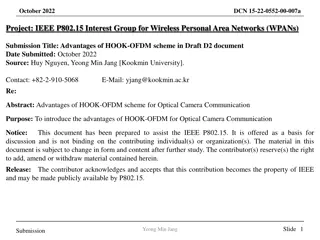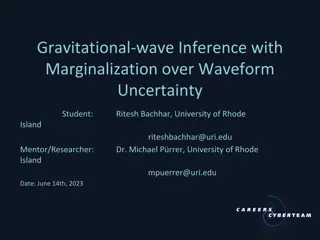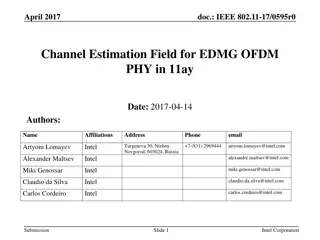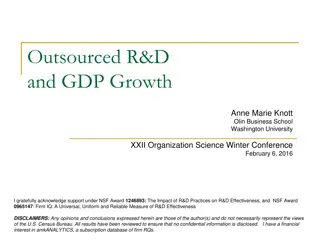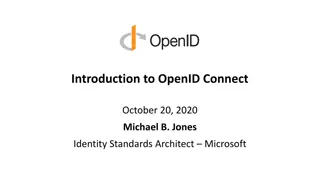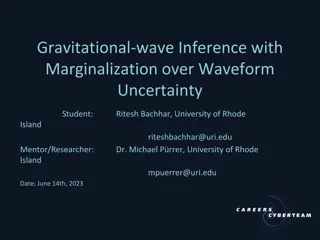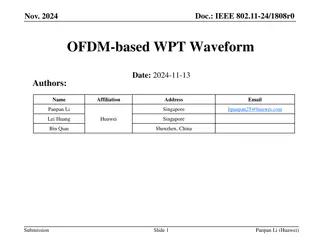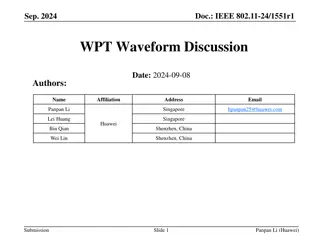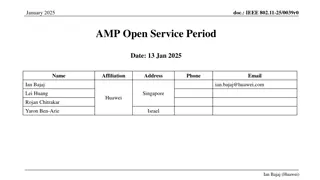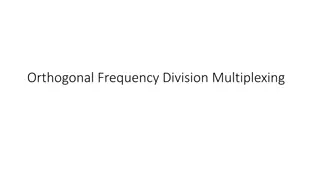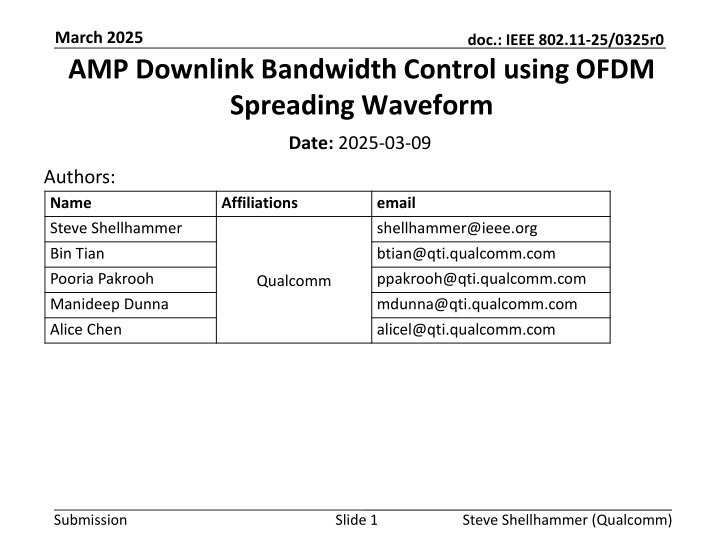
AMP Downlink Bandwidth Control Using OFDM Spreading Waveform
Explore how to enhance downlink bandwidth control through innovative OFDM spreading waveform techniques in IEEE 802.11 specifications for improved signal modulation and transmission efficiency in various regulatory domains such as ETSI and China.
Download Presentation

Please find below an Image/Link to download the presentation.
The content on the website is provided AS IS for your information and personal use only. It may not be sold, licensed, or shared on other websites without obtaining consent from the author. If you encounter any issues during the download, it is possible that the publisher has removed the file from their server.
You are allowed to download the files provided on this website for personal or commercial use, subject to the condition that they are used lawfully. All files are the property of their respective owners.
The content on the website is provided AS IS for your information and personal use only. It may not be sold, licensed, or shared on other websites without obtaining consent from the author.
E N D
Presentation Transcript
March 2025 doc.: IEEE 802.11-25/0325r0 AMP Downlink Bandwidth Control using OFDM Spreading Waveform Date: 2025-03-09 Authors: Name Affiliations email Steve Shellhammer shellhammer@ieee.org Bin Tian Pooria Pakrooh btian@qti.qualcomm.com ppakrooh@qti.qualcomm.com Qualcomm Manideep Dunna mdunna@qti.qualcomm.com Alice Chen alicel@qti.qualcomm.com Submission Slide 1 Steve Shellhammer (Qualcomm)
March 2025 doc.: IEEE 802.11-25/0325r0 Introduction In [1] we described some of the Challenges in spreading a 0.5 s OOK symbols However, we would still like to generate a sufficiently wide Downlink to enable maximum transmit power in both ETSI and China regulatory domains Submission Slide 2 Steve Shellhammer (Qualcomm)
March 2025 doc.: IEEE 802.11-25/0325r0 Background The Task Group agreed to the following [1] o The preamble of an AMP DL PPDU includes L-STF, L-LTF, L-SIG, RL-SIG, and U-SIGs for AMP enabled non-AP STA and active TX non-AP AMP STA Hence Downlink PPDUs transmitted to non-backscatter STAs begin with an OFDM preamble So, from an implementation perspective it make sense to see if we can design the waveform so that the Sync and Data fields are constructed using OFDM Submission Slide 3 Steve Shellhammer (Qualcomm)
March 2025 doc.: IEEE 802.11-25/0325r0 Proposed Approach Instead of generating a 0.5 s OFDM symbol, we propose generating an OFDM Spreading Waveform constructed by a sequence of 4 s OFDM symbols Each OFDM Symbol is multiplied by a random variable (RV) which is equal to either +? or ?, each with probability 0.5 OFDM Spreading Waveform Submission Slide 4 Steve Shellhammer (Qualcomm)
March 2025 doc.: IEEE 802.11-25/0325r0 Proposed OFDM Spreading Waveform Approach (1 Mb/s PHY) Here we look at the 1 Mb/s OOK signal The 0.5 s OOK symbols are shorter in duration than the 4 s OFDM symbols, so a portion of the 4 s OFDM symbol will modulate each 0.5 s OOK symbol o We will call these portions of the OFDM Symbol slices Here is an example illustration: Submission Slide 5 Steve Shellhammer (Qualcomm)
March 2025 doc.: IEEE 802.11-25/0325r0 Proposed OFDM Spreading Waveform Approach (250 kb/s PHY) Here we look at the 250 kb/s OOK signal The 2 s OOK symbols are half the duration than the 4 s OFDM symbols, so half of the 4 s OFDM symbol will modulate each 2 s OOK symbol o We will call these portions of the OFDM Symbol slices Here is an example illustration: Submission Slide 6 Steve Shellhammer (Qualcomm)
March 2025 doc.: IEEE 802.11-25/0325r0 Slices of the OFDM Symbol Eight Slices (for 0.5 s OOK symbols) Two Slices (for 2 s OOK symbols) Submission Slide 7 Steve Shellhammer (Qualcomm)
March 2025 doc.: IEEE 802.11-25/0325r0 Selection of the OFDM BPSK Sequence We are free to select the OFDM BPSK Sequence One of the considerations is the power level in the slices of the OFDM symbol which modulate the OOK Symbols We would like those to be approximately the same power level, so each spread OOK symbol is transmitted at approximately the same power level We want this in the 8 slices of the OFDM symbol used for the 0.5 s OOK symbols (1 Mb/s Downlink) And we want this in the 2 slices of the OFDM symbol used for the 2 s OOK symbols (250 kb/s Downlink) We are also free to select the number of OFDM Tones which are populated BPSK symbols We can use 52 Tones like in 802.11a, or we can use fewer, if we want to simplify the required filtering of the signal, to meet the spectral mask Here we will propose using 50 tones, to ease the filtering requirements Submission Slide 8 Steve Shellhammer (Qualcomm)
March 2025 doc.: IEEE 802.11-25/0325r0 Selection of the OFDM BPSK Sequence We did a search to provide good uniformity of the 8-slice and 2- slice power level We made sure the power level of the weakest slice was close to the average slice power level This is the OFDM BPSK Sequence we identified Sequence = [0, 0, 0, 0, 0, 0, 0, 1, -1, -1, -1, -1, 1, 1, -1, 1, 1, 1, -1, 1, -1, -1, -1, -1, -1, -1, -1, 1, -1, -1, 1, -1, 0, -1, -1, 1, 1, 1, -1, -1, 1, -1, 1, 1, -1, 1, -1, -1, -1, 1, -1, 1, 1, 1, -1, -1, 1, 1, 0, 0, 0, 0, 0, 0,]; Submission Slide 9 Steve Shellhammer (Qualcomm)
March 2025 doc.: IEEE 802.11-25/0325r0 Selection of the OFDM BPSK Sequence Here we provide the slice power levels The average slice power level is set to zero 0.5 s OOK Symbols OFDM Slice Slice Number 1 2 3 4 5 6 7 8 ?.??? ?.??? ?.??? ?.??? ?.?? ?.??? ?.??? ?.??? Slice Power (dB) 2 s OOK Symbols OFDM Slice Slice Number 1 2 ?.??? ?.??? Slice Power (dB) Submission Slide 10 Steve Shellhammer (Qualcomm)
March 2025 doc.: IEEE 802.11-25/0325r0 Power Spectral Density Simulation Generate the OFDM Spreading Waveform and modulate a sequence of 0.5 s OOK symbols o Subsequently we repeat the process using 2 s OOK symbols Apply a filter to the spread waveform to meet the OFDM spectral mask Calculate the PSD of the unfiltered and filtered signals Plot PSD of the unfiltered and filtered signals along with the OFDM spectral mask Submission Slide 11 Steve Shellhammer (Qualcomm)
March 2025 doc.: IEEE 802.11-25/0325r0 Calculation of Maximum Allowed TX power in ETSI and China Regulatory Domains Using filtered signal PSD, we search from over all 1 MHz sections of the PSD Based on the power in the largest 1 MHz section we calculate the maximum allowed power based on ETSI and China PSD limits We report that value If that value is larger than 20 dBm we are then limited by the maximum power limit of 20 dBm Submission Slide 12 Steve Shellhammer (Qualcomm)
March 2025 doc.: IEEE 802.11-25/0325r0 Power Spectral Density (1 Mb/s Downlink PPDU) Meets the OFDM Spectral Mask (as shown in Black) Calculated the PSD TX Power limit for ETSI & China = 21.4 dBm So, we can transmit at 20 dBm o The absolute max TX power Submission Slide 13 Steve Shellhammer (Qualcomm)
March 2025 doc.: IEEE 802.11-25/0325r0 Power Spectral Density (250 kb/s Downlink PPDU) Meets the OFDM Spectral Mask (as shown in Black) Calculated the PSD TX Power limit for ETSI & China = 21.2 dBm So, we can transmit at 20 dBm o The absolute max TX power Submission Slide 14 Steve Shellhammer (Qualcomm)
March 2025 doc.: IEEE 802.11-25/0325r0 Conclusions We proposed a OFDM Spreading Waveform to spread both the 1 Mb/s and 250 kb/s Downlink for the non-backscatter STAs Transmission of 250 kb/s Downlink PPDU for backscatter STAs needs more discussion The spread waveform, with filtering, meets the OFDM spectral mask The PSD of the spread (and filtered) waveform enable the Access Point (AP) to transmit at 20 dBm, which is the maximum allowed TX power in ETSI and China regulator domains We showed that an OFDM Symbol can be generated such that the power level of the slices of the OFDM Symbol, for each OOK Symbol, are very close to the average OFDM slice power Submission Slide 15 Steve Shellhammer (Qualcomm)
March 2025 doc.: IEEE 802.11-25/0325r0 Straw Poll Do you agree to add the following content to the 802.11bp SFD: o The AMP Downlink PPDU shall utilize OFDM Spreading Waveform Submission Slide 16 Steve Shellhammer (Qualcomm)
March 2025 doc.: IEEE 802.11-25/0325r0 References 1. Steve Shellhammer, et. al., Challenges in Downlink Bandwidth Control in 1 Mb/s PPDU, IEEE 802.11-25/0324r0, March 2025 Submission Slide 17 Steve Shellhammer (Qualcomm)

